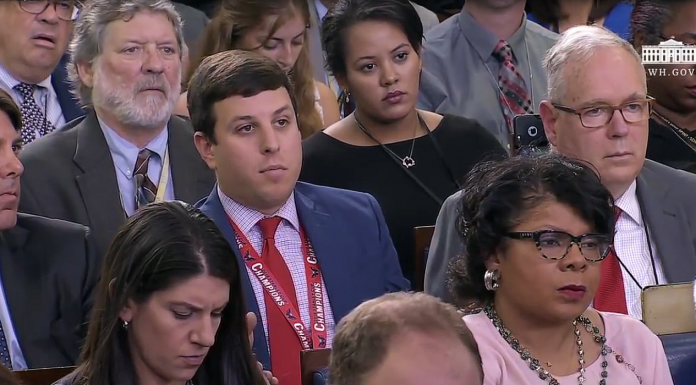(Headline USA) An overwhelming majority of mainstream mass media is teeming with aggressively left-wing reporters, editors and staff, with scant representation of conservative voices in the mix.
But the News Leaders Association, a left-tilted journalism trade group, is more concerned with efforts to diversify newsrooms as defined by the colors of reporters’ skins or their sex, and is none too happy that the ability to measure what they deem real progress on that front is proving elusive.
In response, the group extended the deadline for responses to its survey about employment practices at news organizations for two months, after expressing disappointment about how few are willing to reveal the diversity of their staffs.
The group hoped for as much participation as possible from an estimated 5,900 newsrooms across the country, but it has had fewer than 250 responses, said Meredith Clark, a Northeastern University professor who is running the survey.
Still, there have been tangible signs of mass media groups bowing to the pressures of so-called social justice for the industry, most notably in diverse hires for some major journalism jobs:
- Kevin Merida, the second black executive editor of the Los Angeles Times after current New York Times executive editor Dean Baquet
- Kim Godwin and Rashida Jones, both black women, as presidents of ABC News and MSNBC
- Katrice Hardy and Monica Richardson, the first black executive editors at the Dallas Morning News and Miami Herald
- Daisy Veerasingham, the first woman and first person of color appointed as the Associated Press’ president and CEO.
Newsrooms throughout the extremely leftist Gannett chain, the New York Times, the Washington Post and NBC News have publicly revealed statistics on diversity hiring. Despite these steps, the overall diversity picture—as defined by sex and skin color—remains blurred.
First through a precursor, the American Society of News Editors, a newsroom diversity survey has been conducted since the mid-1970s, following a Kerner Commission report that described the absence of black journalists as “shockingly backward.”
News organizations were given a goal of having staffs that reflected their communities by 2000.
“The more diversity you have in your newsroom, the better you are able to capture what is going on in your community,” said Myriam Marquez, executive director of the news leaders group, which includes executives at newspapers, websites and media groups.
A lack of skin-color diversity can supposedly reveal itself in many news decisions: To many with leftist leanings and bias, the attention paid to the story of Gabby Petito, a young woman found dead after a cross-country trip with her fiance, reflected a supposed long-term concern about journalists paying more attention to missing white women than minorities in similar situations.
Despite some improvements, the 2000 goal wasn’t reached, and concerns about diversity faded with the industry’s financial collapse over the past two decades. Participation in the annual survey also became spotty, to the point where it was suspended in 2019 after only 293 responses were received.
Clark was hired to create a more thorough and modern questionnaire, and to seek ways to get more participation, since internal peer pressure is proving insufficient.
Since organizations are being asked to volunteer information—as opposed to a random sample being taken—it also stands to reason that organizations making progress toward meeting leftist-endorsed diversity goals would be most likely to participate, lending doubt about whether the survey will truly reflect what is going on.
It may be a more long-term solution, but the group is considering asking foundations and others who provide funding for news organizations to require participation in the survey before getting a grant.
In some corners, that would seem strikingly akin to offering bribes for compliance. A similar approach is being championed to journalism prizes: If you want to enter the competition for a Pulitzer, show you’ve filled out a survey … and have conformed to racial quotas demanded by the leftists who set them.
Clark said her goal was to have 1,500 responses to produce a statistically solid report. It seems doubtful they’ll get there by the end of October, the new deadline.
There’s a baseline of participants including Gannett, McClatchy newspapers, ProPublica, Buzzfeed and the Associated Press—the latter for the first time—-that the information will be worth releasing.
“I think these participating organizations, by proving their commitment, will gain a recruiting advantage and that will encourage others,” said George Stanley, NLA president and editor of the Milwaukee Journal Sentinel.
The New York Times said earlier this year that the percentage of non-white staff members had increased from 27% in 2015 to 34% last year. At the Times, Washington Post and USA Today, a majority of the newsroom staff are women.
The AP reported that 76% of its full-time news employees in the United States are white, 8% are Latino, 7% are black and 6% are Asian. News management is 81% white.
Despite having espoused diversity as a social imperative on their pages, however, few of the white newsroom leaders have been willing to voluntarily sacrifice their own posts to advance the cause.
When he began as head of news at NBC Universal last year, Cesar Conde publicly set a goal of a staff that is 50% minority and 50% women, although he gave no deadline. Since then, monthly hires have averaged 48% people of color and 63% women, the network said. The division’s percentage of minorities has increased from 27% to 30%.
Adapted from reporting by the Associated Press.

